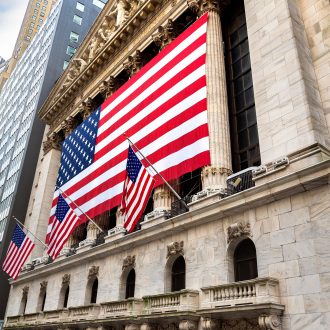
The Debt Ceiling Debacle
The Flyover:
- Turbulence, not tragedy. That’s what I’d expect from the financial markets as we wade through this embarrassing season for our country.
- Trying to take advantage of short-term volatility will be extremely dangerous since the swings in both directions can be very sharp and sudden.
- Investors will be best served to focus on what lies beyond this current drama, which is the growing probability of increasing asset values after a bit more time trending mostly sideways.
Winston Churchill is credited for making the brilliant observation that Americans will always do the right thing, but only after they have tried everything else. It was true in his day and seems to still be true today.
America is yet again grappling with a debate about whether to raise the nation’s debt ceiling and the concessions that need to be made by both parties to come to an agreement.
Please understand that I don’t intend to undermine the importance of debating and negotiating around the debt ceiling in DC. However, I have no problem pointing out the unenviable way the game of politics is played. Goldman Sachs data says that at the peak in 2021 we were at 134% debt to GDP. It’s cold comfort to say that we’ve brought that level down to 120% since then. So clearly we have an issue and something needs to be done. But it doesn’t need to be done by becoming a deadbeat nation that doesn’t pay for its past congressionally approved spending. It needs to be done by governing better every day.
These debates become public displays of our political ineptitude and create frightening storm clouds on the horizon for the economy and investors.
Sometimes storm clouds are so bad the pilot decides to reroute the plane. Other times they just create an unnerving chop, and the pilot decides to forge ahead through the turbulence they create.
In my view, this debt ceiling issue is akin to the pilot saying “fasten your seatbelts because we expect some turbulence ahead”. This is not a pilot saying we will be delayed on the way to our destination because we need to avoid something more severe.
Thankfully, as investors we have the benefit of a blueprint from the past to help prepare us for what to expect now.
First, we all need to be realistic about the sensationalism at play here. Don’t be on the lookout for common sense and consistency from the boys and girls in DC. Instead, we need to start by disregarding the fact that politicians from both parties have voted to increase the debt ceiling time and again. To that point, Invesco cites that the debt ceiling has been raised more than 100 times since the end of World War II, under Republican and Democratic administrations alike. Forbes states Congress has raised the debt ceiling 78 times since 1960; 49 of under a Republican president and 29 under a Democrat. This time around they want to turn against their past logic to play political games. It only underscores the political hypocrisy that exists in our country.
Next, we need to see what we might be able to learn about market behavior during these periods. The past handful of debt ceiling increases have been unceremonial, so it’s been a while since we had a debt ceiling debate come this close to going ‘all the way’. That was back in 2011. Do you remember how the financial markets performed?
At first they were down because of the sheer nervousness of the moment, but once the crisis was addressed, to say there was a strong recovery would be an understatement. Beyond the initial snapback rally, financial markets of all types performed far above average for several years. This memory encourages us to recognize this as a period of turbulence, but not likely the type of thing that changes the course of the plane.
Could this 2023 episode be similar to that of 2011? Could it lead to the same market disruptions, or even worse? I doubt it.
The odds of a deal being struck before it’s too late are very high. Both political parties have a substantial vested interest.
In particular the current president really cannot afford to lose political face or risk bringing on an almost certain round of job losses as the reelection cycle kicks in. His political counterparts aren’t exactly enjoying tremendous strength at the moment, and they’d look to benefit from any sort of momentum they can create. In short, they are both likely to negotiate regardless of their public stances.
As we all know, politicians will always find credible and convenient ways to blame the other side for any air pockets no matter what the truth happens to be. So I expect a ton of harsh jawboning, fear mongering, and political theater all the way to the brink, but then I expect a resolution.
Ironically, both sides of the aisle will likely have nothing to wear but embarrassment when they run their victory laps as self-described saviors of our society. In case we didn’t already know, this should show We The People yet again how little politicians really care about anything beyond their own reelection.
Regardless of the drama, as we get resolution on the debt ceiling, we are most likely going to see markets move along unaffected outside of the turbulence felt as we went through the storm.
Long-term investors should simply recognize this as one of the headaches of the investing process. Headline risks like these always create volatility, but they rarely create a true change of direction.
Short term investors might want to try to game the situation by preparing for a dip. I would caution against this. These types of situations are typically resolved by deals struck in the middle of the night and short positions could be ruined before any opportunity to close out at a profit exists. This could turn profitable guesses into losers in the blink of an eye.
The Market Environment Beyond the Current News Cycle
In recent issues of Worth Considering, I’ve outlined my opinion that we are in a waiting game with the markets. Given that CNBC is reporting the average component of the S&P 500 index is down 0.5% year to date and up less than 0.2% for the trailing twelve months, there is evidence that this might be happening.
Very recently there has been a surge in a handful of index components, specifically the large cap tech cohort. Outside of that small minority, stocks on the whole are in a holding pattern.
For what it’s worth, I would be more inclined to believe the small number of stocks that have recently jumped will fade back in line with the majority around the flat line rather than the other way around.
That’s OK by me. It is in keeping with my theme that stocks are essentially resting before they move higher, and I continue to fully expect the markets to be in confirmed uptrends within a few quarters.
There is an old saying that familiarity breeds contempt, but please don’t let that happen here.
The fact that the financial markets are sticking around familiar territories isn’t something to have contempt over. In fact, it’s quite the opposite.
These plateau phases provide stable foundations for future growth.
I suggest you enjoy a good laugh from time to time as you listen to boneheaded TV personalities talk about such a highly volatile market. If this isn’t proof that they don’t know anything other than to say what they’ve always said, I don’t know what is. This market is temporarily stuck in neutral. So be it. History suggests that’s a very good thing for those who are patient.
The Takeaways:
- Expect the debt ceiling issue to be taken all the way to the brink before it is ultimately resolved.
- As that plays out, don’t be surprised or scared if financial assets leak lower in acknowledgment of the uncertainty of the moment.
- As much as I don’t know what the headlines and market action of the next few weeks will be, I believe it has next to nothing to do with what they will be in the quarters ahead. I think it would be foolish to overreact and risk seller’s remorse in response to this particular news cycle.
- I continue to believe the broad spectrum of financial assets will move sideways a while longer before the continuation of the uptrend. The good news is that we’re now several months into this pattern which means we’re that much closer to the uptrend. But it is still premature to expect right away.
Disclosure
All e-mail sent to or from this address will be received or otherwise recorded by the International Assets Advisory, LLC corporate e-mail system and is subject to archival, monitoring or review by, and/or disclosure to, someone other than the recipient. This information is obtained from sources believed to be reliable; however, its accuracy or completeness is not guaranteed. Investing in securities underlying in currencies other than the U.S. dollar involves certain considerations comprising both risk and opportunity not typically associated with investing in U.S. securities. The security may be affected either favorably or unfavorably by fluctuation in the relative rates of exchange between currencies, by exchange control regulations, or by indigenous economic and political developments. As with any investment, there is no guarantee against potential loss. Past performance is not an indication of future performance. International Assets Advisory, LLC and its affiliates, employees and/or directors may have positions in these securities, and may as principal or agent, buy from or sell to customers. All securities are subject to price and yield change and subject to availability. Mutual funds, Unit Investment Trusts and Variable Annuities are sold by prospectus only. Please read the prospectus carefully for important information about fees and risk considerations.
Securities offered through International Assets Advisory LLC Member FINRA/SIPC. The information provided is based on carefully selected sources, believed to be reliable, but whose accuracy or completeness cannot be guaranteed. Any opinion herein reflects our judgment at this date and is subject to change without notice. This should not be construed as an offer or solicitation to buy or sell securities. Investors should consider the investment objective, risks, and charges and expenses before investing in an investment company product. Stocks, options, and mutual funds are subject to market volatility and the chance that they may lose value. Bonds are subject to changes in interest rates, risks of defaults by issuer, and the loss of purchasing power due to inflation, or the risk that an issuer will be unable to make interest or principal payments. Additionally, bonds and short-term investments entail greater inflation risk than stocks. Any fixed-income security sold or redeemed prior to maturity may be subject to a substantial gain or loss.
Different types of investments involve varying degrees of risk, and there can be no assurance that any specific investment will be either suitable or profitable for a client or prospective client’s wealth management investment portfolio.
This information is not intended to be legal or tax advice. Please consult a tax, legal, or financial professional with questions.
Investing in securities underlying in currencies other than the U.S. dollar involves certain considerations comprising both risk and opportunity not typically associated with investing in U.S. securities. The security may be affected either favorably or unfavorably by fluctuation in the relative rates of exchange between currencies, by exchange control regulations, or by indigenous economic and political developments. As with any investment, there is no guarantee against potential loss. Investments in securities and insurance products are:
NOT FDIC-INSURED/NOT BANK-GUARANTEED/MAY LOSE VALUE



